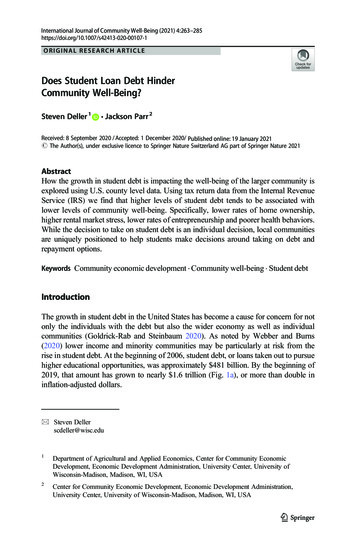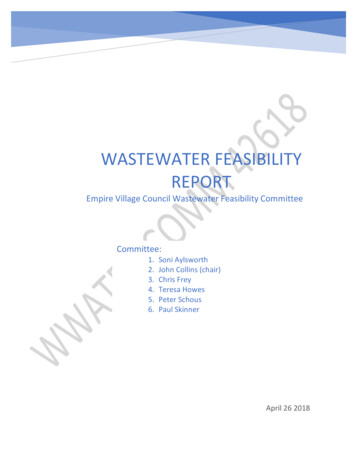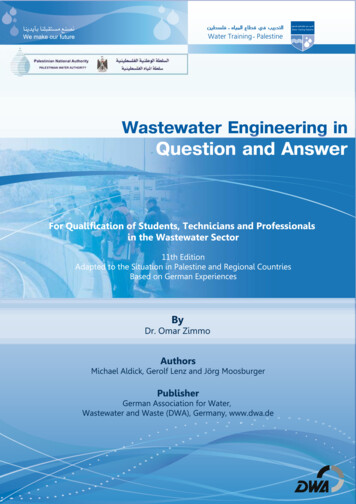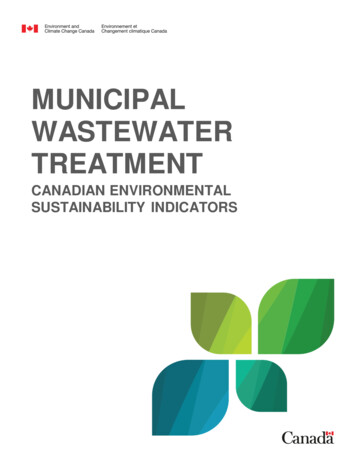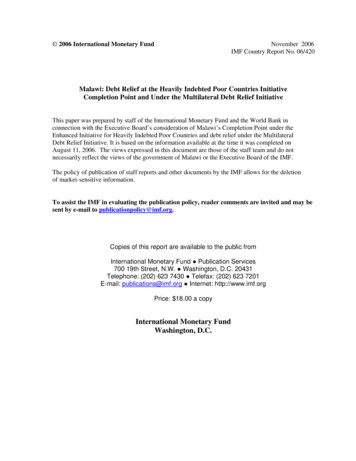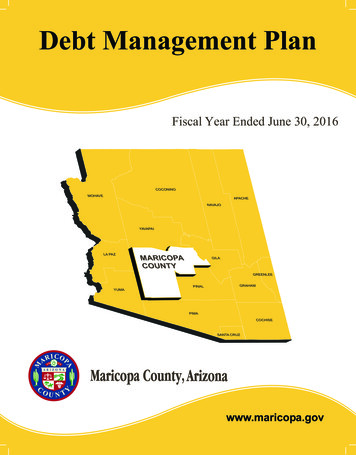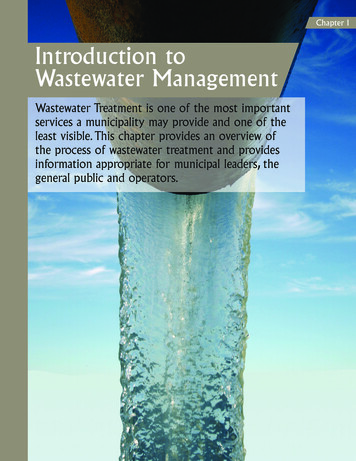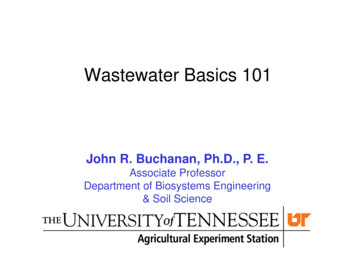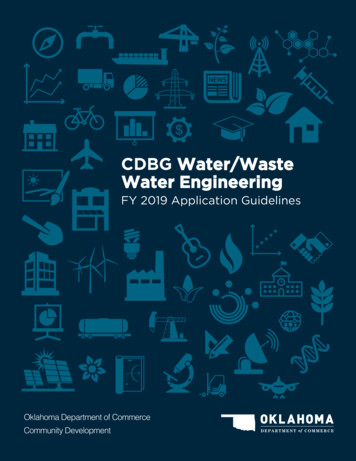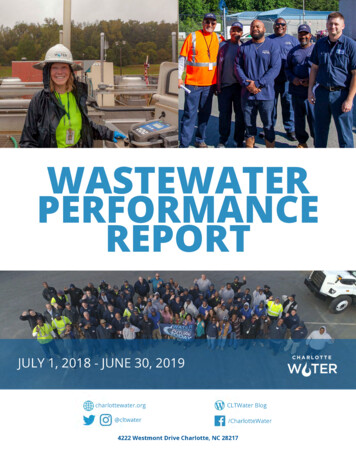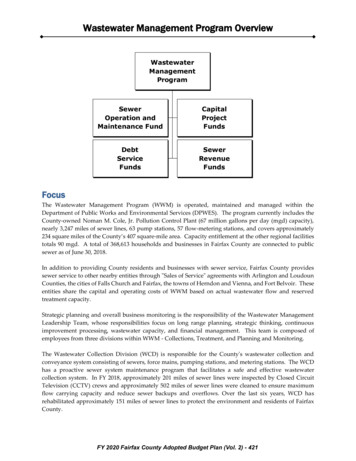
Transcription
Wastewater Management Program OverviewWastewaterManagementProgramSewerOperation andMaintenance eFundsFocusThe Wastewater Management Program (WWM) is operated, maintained and managed within theDepartment of Public Works and Environmental Services (DPWES). The program currently includes theCounty-owned Noman M. Cole, Jr. Pollution Control Plant (67 million gallons per day (mgd) capacity),nearly 3,247 miles of sewer lines, 63 pump stations, 57 flow-metering stations, and covers approximately234 square miles of the County’s 407 square-mile area. Capacity entitlement at the other regional facilitiestotals 90 mgd. A total of 368,613 households and businesses in Fairfax County are connected to publicsewer as of June 30, 2018.In addition to providing County residents and businesses with sewer service, Fairfax County providessewer service to other nearby entities through "Sales of Service" agreements with Arlington and LoudounCounties, the cities of Falls Church and Fairfax, the towns of Herndon and Vienna, and Fort Belvoir. Theseentities share the capital and operating costs of WWM based on actual wastewater flow and reservedtreatment capacity.Strategic planning and overall business monitoring is the responsibility of the Wastewater ManagementLeadership Team, whose responsibilities focus on long range planning, strategic thinking, continuousimprovement processing, wastewater capacity, and financial management. This team is composed ofemployees from three divisions within WWM - Collections, Treatment, and Planning and Monitoring.The Wastewater Collection Division (WCD) is responsible for the County's wastewater collection andconveyance system consisting of sewers, force mains, pumping stations, and metering stations. The WCDhas a proactive sewer system maintenance program that facilitates a safe and effective wastewatercollection system. In FY 2018, approximately 201 miles of sewer lines were inspected by Closed CircuitTelevision (CCTV) crews and approximately 502 miles of sewer lines were cleaned to ensure maximumflow carrying capacity and reduce sewer backups and overflows. Over the last six years, WCD hasrehabilitated approximately 151 miles of sewer lines to protect the environment and residents of FairfaxCounty.FY 2020 Fairfax County Adopted Budget Plan (Vol. 2) - 421
Wastewater Management Program OverviewThe Wastewater Treatment Division (WTD) is responsible for operating and maintaining the County'swastewater treatment facility, the Noman M. Cole, Jr. Pollution Control Plant (NCPCP). The WTDcontinues to produce a quality effluent to meet regulatory and permit requirements, despite majorconstruction occurring throughout the plant site. The NCPCP has started the rehabilitation of the plant’sbio-solids facilities, which includes additional air pollution control systems, and complete rehabilitation ofall four incinerators, which will include energy recovery.The Wastewater Planning and Monitoring Division (WPMD) is responsible for the agency's fiscal planning,engineering planning, and wastewater monitoring. The WPMD continues to effectively monitor the longterm needs for the Wastewater Management Program in terms of infrastructure upgrades, maintenance,and expansions. The WPMD ensures that all financial requirements are fulfilled by maintaining a ratestructure to adequately recover all operating and maintenance costs, capital improvements and debt serviceobligations. The WPMD also plans for system capacity, both in the conveyance system and treatmentfacilities, by initiating expansion and improvement projects to keep pace with increased wastewater flows.The WPMD safeguards the environment by ensuring compliance with water quality standards andprevention of toxic discharges into the collection system.WPMD is currently monitoring the Chesapeake Bay water quality program, which requires reductions inthe amount of nutrient pollutants discharged from wastewater treatment facilities. In December 2004, thestate notified the County that the renewal of the County’s Virginia Pollutant Discharge Elimination System(VPDES) permit includes a requirement that nutrient removal be performed using “State of the Art”technology and meet a waste load allocation (cap) for the nitrogen and phosphorous nutrients. A phasedapproach was used to renovate and upgrade current plant facilities to accommodate these more stringentnutrient discharge requirements. These renovations and upgrades were completed in FY 2015. Otherregional plants serving the County are at various stages of upgrade for compliance with the newrequirements.The Wastewater Management Program is primarily supported by Sewer Service Charges received fromexisting customers, which are used to fully recover program operation and maintenance costs, debt servicepayments and capital project requirements attributable to improving wastewater treatment effluent qualityas mandated by state and federal agencies. The five-year sewer rate plan approved by the Board ofSupervisors as part of the FY 2019 Adopted Budget Plan proposed to increase the sewer charges by 5.9percent in FY 2020. After a careful review, the Wastewater Management staff recommended to increasethe sewer charges by only 4.8 percent in FY 2020, which will result in an annual increase of 30.28 to thetypical household. The Sewer Service Charge will increase from 7.00 to 7.28 per 1,000 gallons of waterconsumed based on Fairfax County’s winter quarter average consumption of 18,000 gallons.The Base Charge will increase from 30.38 per quarter to 32.91 per quarter. The Base Charge provides fora more equitable rate structure by recovering a portion of the program’s costs. The industry practice for afixed charge revenue rate is 25 percent of operating revenues. The expected fixed charge revenuepercentage in FY 2020 is 20.9 percent. The current system, including sewer lines, facilities, purchasedcapacity and equipment, is valued at approximately 2.0 billion. Based on the age and requiredmaintenance of the system, reinvestment must continue to be addressed. The implementation of theincreases to the Base Charge will help ensure that all users of the system share in the costs associated withreinvestment and operations.FY 2020 Fairfax County Adopted Budget Plan (Vol. 2) - 422
Wastewater Management Program OverviewIncreases to both the Sewer Service Charge and Base Charge will change the annual average customer billfrom 625.52 in FY 2019 to 655.80 in FY 2020, a cost increase of 30.28 or 4.8 percent. The FY 2020 averagebill in Fairfax County is one of the lowest compared to the average bill in other regional jurisdictions evenwith the proposed increases. The increases in the Sewer Service Charge and Base Charge will partiallyoffset the increased costs associated with capital project construction, system operation and maintenance,debt service and upgrades to meet new, more stringent nitrogen discharge limitations from wastewatertreatment plants.YearSewer Service ChargeBase ChargePer 1,000 gallons water2019Per Quarterly BillSewer ChargesPercentage IncreaseBase ChargeRevenue Percentage 7.00 30.38NA20.1%2020 7.28 32.914.8%20.9%2021 7.64 36.206.0%21.8%2022 8.02 39.826.0%22.7%2023 8.28 43.974.8%23.9%2024 8.56 48.294.8%25.1%The Wastewater Management Program is also supported by the Availability Charge, which is a one-timecharge to new customers for initial connection to the system. The revenue from the Availability Charge isused to offset the costs of expanding treatment facilities. In FY 2020, the Availability Charge will increasefrom 8,100 to 8,340 for single-family homes based on current projections of capital requirements. Ratesare based on requirements associated with treatment plant upgrades and interjurisdictional payments thatresult from population growth, more stringent treatment requirements and inflation. The FY 2020 rate isconsistent with the recommendations of the Department of Public Works and Environmental Services andthe analysis included in the Wastewater Revenue Sufficiency and Rate Study Forecasted Period Fiscal Year2019 though Fiscal Year 2024. Rates are expected to remain at the FY 2020 level through FY 2024. Thefollowing table displays the rates by category:FY 2019Availability ChargeFY 2020Availability ChargeSingle Family 8,100 8,340Townhouses and Apartments 6,480 6,672Hotels/Motels 2,025 2,085Nonresidential 405/fixture unit 417/fixture unitCategoryAs part of the FY 2020 Advertised Budget Plan, the Wastewater Management staff recommended toestablish charges to recover a portion of the cost of disposal and treatment of hauled wastewater at theCounty’s septage receiving facility (SRF), which is located at the NCPCP. As part of the FY 2020 AdoptedBudget Plan, the Board of Supervisors approved the establishment of charges for hauled wastewater.The County’s SRF was constructed to receive and treat septage from local onsite sewage disposal systemsin accordance with Code of Virginia Ann. Section 15.2-2123. In addition, the SRF receives landfill leachate,portable toilet waste, restaurant grease, and recycled carwash water. Hauled septage and wastewater usedto be received and treated at no cost to pump and haul contractors to encourage proper disposal. This costused to be covered by the sewer charges paid by the customers of the County’s public sewer system. Thenew charges will improve equity among customers served by the sewer system and those served by theFY 2020 Fairfax County Adopted Budget Plan (Vol. 2) - 423
Wastewater Management Program Overviewpump and haul contractors. Also, the charges will recover a portion of the costs of operation, maintenance,and upcoming necessary improvements to the SRF.DPWES will initially set the charges at a level comparable to the fees charged by the Upper OccoquanService Authority (UOSA), the only other facility in the County that receives hauled wastewater. Sinceseptic tank and restaurant grease waste has higher strength than portable toilet and landfill leachate waste,the charge for high strength waste will be 27 per 1,000 gallons of the hauler’s truck capacity. The fee forlow strength waste will be 7.28 per 1,000 gallons of hauler truck capacity, which is based on the prevailingsewer service charge and will be modified as the sewer service charge is adjusted in the future. Theprojected FY 2020 revenue from charges for hauled wastewater is equal to 250,000.Health Departments in neighboring jurisdictions charge hauling contractors a separate registration fee.Previously, the Fairfax County Health Department charged pump and haul contractors a fee of 710 peryear for the first truck and 360 per year for each additional truck for inspection and registration. Incollaboration with DPWES and in consideration of the approved new hauled wastewater charges, theFairfax County Health Department will implement the following amendments to be comparable to otherjurisdictions in FY 2020: Charge 150.00 for each vehicle,Charge 200.00 for late renewals (after January 31 of each year), andEliminate the current process of prorating fees during the year.This level of revenue in FY 2020 will allow the system to meet permit conditions, meet and maintain all ofthe required financial targets through FY 2024, maintain competitive rates with neighboring utilities,continue to preserve its AAA bond rating, and require less debt to support capital projects.The table on the following page reflects the Wastewater Management Program’s projected fiscal health inFY 2020 and FY 2021. The financial planning process incorporates the following indicators that areinterrelated and structured to identify the adequacy of rates from a cash flow, business, and compliancestandpoint. These indicators are used by the rating agencies to determine the Program’s credit rating.Calculated Financial IndicatorsFinancial IndicatorNet Revenue MarginDays Working Capital1Debt Coverage SeniorDebt Coverage All-inTarget45.0% to 55.0%150 to 200 daysMin. 3.00x2.00x to 2.50xAffordability (% of median income spent on sewer bill)Less than 2.0%Below 35.0%Never above 45.0%Max 3,000Debt to Net Plant in ServiceOutstanding Debt per ConnectionAnticipated Sewer Bond Sales Through FY 2020AchievedYesYesYesYesFY 202050.2%1523.29x2.07xFY 202151.8%1523.59x2.29xYes0.6%0.6%YesYes34.3% 1,66835.6% 1,756 130 million(1) The Days Working Capital financial indicator is exclusive of Availability Charges in Fund 69000, Sewer Revenue, and Fund 69300,Sewer Construction Improvement. It is calculated based on Operating Expenses and 360 days.It is anticipated that the rates in FY 2020 will support the County’s ability to maintain high bond ratings(AAA by Fitch Investor Service and Standard and Poor’s Corporation and Aaa by Moody’s InvestorsService, Inc.) from the rating agencies. These high credit ratings have enabled the County to sell bonds onbehalf of the Program at interest rates lower than those obtained by most sewer authorities, therebyachieving savings throughout the life of the bonds. The Wastewater Management Program has issued debtFY 2020 Fairfax County Adopted Budget Plan (Vol. 2) - 424
Wastewater Management Program Overviewto fund major expansion and upgrade projects for both its own plant and its portion at the “Treatment byContract” facilities.In FY 2020, the County is projected to provide for the treatment of 104.6 million gallons of wastewater perday. Approximately 37 percent of this flow is treated at the NCPCP. The flow is distributed between theNCPCP and the interjurisdictional facilities as detailed in the table below. The table also includes thecapacity utilization percentage and the available (unused) capacity for each plant.CapacityTreatment Plant(mgd)FY 2020ProjectedDaily )(mgd)DCWASA Blue Plains31.028.591.9%2.5Noman M. Cole, Jr.67.039.058.2%28.0Alexandria Renew 61.1%8.81.00.00.0%1.0157.0104.666.6%52.4Arlington CountyUpper Occoquan Service AuthorityLoudoun WaterTotalTo ensure that WWM remains competitive and provides a high-performance operation includingimprovements to the technical and managerial capacities that will continue to enhance service quality,customer service and financial planning, WWM closely monitors the following areas:Sewer Service Charge, /1,000 gallonsFY 2018FY 2019FY 2020(Actual)(Adopted)(Adopted) 6.75 7.00 7.28 1,903 1,951 1,999Number of Sewer System Overflows201515Odor Complaints per year161515Treatment Costs, /MGDThe WWM comprises seven separate funds under a self-supporting fund structure (Enterprise Funds)consistent with the Sewer Bond Resolution adopted by the Board of Supervisors in July 1985. For moredetailed information of the operational aspects of the various programs, refer to the narrative of Fund69010, Sewer Operation and Maintenance, which follows this Overview. The following is a briefdescription of the seven active funds: Fund 69000 - Sewer Revenue is used to credit all operating revenues of the system, as well as most ofthe interest on invested fund balances. Revenues recorded in this fund are transferred to the variousfunds to meet their operational requirements. The remaining fund balances are used to set aside fundsfor various reserves and future system requirements. Fund 69010 - Sewer Operation and Maintenance provides funding for the three divisions responsiblefor the management and operation of the program supported by a transfer from Fund 69000.FY 2020 Fairfax County Adopted Budget Plan (Vol. 2) - 425
Wastewater Management Program Overview Fund 69020 - Sewer Bond Parity Debt Service is used to record principal, interest, and fiscal agent feesfor the 2009, 2012, 2014, 2016 and 2017 Sewer Revenue Bonds in accordance with the current SewerBond Resolution supported by a transfer from Fund 69000. Fund 69030 - Sewer Bond Debt Reserve provides debt reserve funds for the 2009 Sewer Revenue Bonds,the 2012 Sewer Revenue Bonds, the 2014 Sewer Refunding Bonds, the 2016 Sewer Refunding Bonds,the 2017 Sewer Revenue Bonds, and the planned 2020 Sewer Revenue Bonds in accordance with thecurrent Sewer Bond Resolution, which are funded from the issuance of sewer revenue bonds and/orprogram revenues. Fund 69040 - Sewer Bond Subordinate Debt Service records all debt service payments on the UpperOccoquan Service Authority (UOSA) revenue bonds and Virginia Resources Authority (VRA) loans.All future issues or refinancing of debt arising from interjurisdictional capacity rights may be treatedas subordinate obligations of the system as provided by the General Bond Resolution for SewerRevenue Bonds. Funding is supported by a transfer from Fund 69000. Fund 69300 - Sewer Construction Improvements provides funding for the repair, rehabilitation andimprovement requirements of the entire program's infrastructure supported by a transfer from Fund69000. Fund 69310 - Sewer Bond Construction provides for major program construction projects, which arefunded from the issuance of sewer revenue bonds and/or program revenues.FY 2020 Fairfax County Adopted Budget Plan (Vol. 2) - 426
nearly 3,247 miles of sewer lines, 63 pump stations, 57 flow-metering stations, and covers approximately 234 square miles of the County's 407 square-mile area. Capacity entitlement at the other regional facilities totals 90 mgd. A total of 368,613 households and businesses in Fairfax County are connected to public sewer as of June 30, 2018.

